by Winding Pathways | Jul 19, 2018 | (Sub)Urban Homesteading, Amphibians/Reptiles, Birds, Garden/Yard, Mammals, Nature
Susan Hrobar
guest blogger
Fun Through the Window
We are fortunate to live at the end of a channel on a small lake. Our north facing windows face our backyard and the channel. One of our friends, who knows very little about nature, does not understand that after living here for 18 years, we still get excited when we see any wildlife in our yard and in the channel. Most of my photos are taken from windows inside the house, hoping to not spook my photo subjects. We frequently have deer coming through and we can tell which paths are being worn into the ground. During the winter we’ve taken photos of deer amidst the falling snowflakes. And, on our trail cam, we have “caught” coyotes, fox, raccoons, opossums, and neighborhood kitties.
Tom Turkey
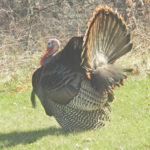
Strutting
This spring we have had a special bonus of occasionally watching a male turkey strut between our and the neighbors’ yards. Usually, he is skittish and if he spots me looking out a window, he quickly moves out of sight. One morning he must have felt like he was “king of the hill” and actually posed for photos about 20 feet from where I was watching him. I have also watched him fly over the channel near dusk and find a tree to roost in for the night. It always amazes me to watch these big birds fly through the trees, as normally you only see them walking and running on the ground.
Turtle Habitat
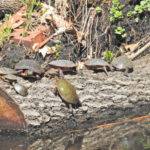
Lounging on a log
Last summer when the water level was high, an oak tree uprooted and fell into the channel, covering both sides of the channel, and completely blocking our water access to the main lake. Because the channel is narrow, there is little clear land on either side. The oak landed at the bottom of a steep hill, so removing it was quite a process. It took a bucket truck on top of the hill, a small boat in the channel, lots of ropes, and a very talented arborist to take care of the problem. This spring the water is lower and that downed tree is now a horizontal stump about four feet long partially submerged from where it fell.
The turtles love this new sunning perch! We have never seen so many turtles at one time. So far, our biggest count has been nine painted turtles on the log. In spring we sometimes get lucky to see a large soft-shell turtle swimming in the channel and climbing out onto the shore. The females are much larger than the males.
Wood Duck- Goose Dustoff
On a recent rainy day, we spotted a pair of wood ducks. They are also very skittish and do not like to pose for photos. We watched as they flew up into a large basswood tree and perched on the branch. I think that is the first time I have ever seen ducks sitting in the trees. It was not a great day for photos, but I tried anyway.
The ducks flew to another tree, rested for a while, and then flew down to the water. Mr. Wood Duck and Mr. (Canada) Goose then had an altercation on the grass with much hissing, honking, flapping of wings, and chasing.
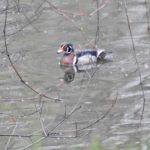
Male wood duck
Mr. Wood Duck was very proud of himself for chasing the goose parents and two goslings of out “his” channel. Mrs. Wood Duck cheered him on while sitting on top of our boat motor. My husband, John, had the fun of watching the goose and duck stand-off. I was trying to get to a different window without all the raindrops obscuring my view. That did not work, but it made me smile to hear John laughing and enjoying the whole spectacle.
Loving Our Wildlife
Even after nearly two decades, we still so enjoy our yard and sharing our stories about animals and plants.
-
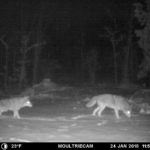
-
Night activity
-
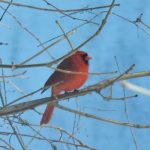
-
Male Cardinal in a tree.
-
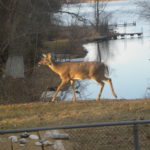
-
Deer in yard.
-
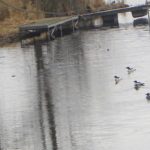
-
Swimming
-
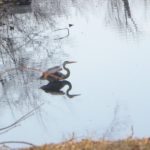
-
A heron spreads its wings
-
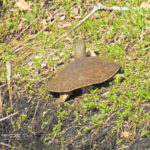
-
Female soft shells are larger than the male.
by Winding Pathways | May 3, 2018 | Birds, Mammals, Nature
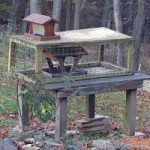
Keeping Squirrels at bay
Bruce Frana, a Winding Pathways visitor, saw one of our blogs on our “squirrel proof” feeder and how we discourage squirrels from gobbling up sunflower seeds we put out for birds. He crafted a similar but much more attractive version that’s in his yard. Our contraption is a box framed with 2X2 lumber with sides of 2” x 2” wire mesh. A piece of plywood forms the roof, and we attached it to a wooden table with a pair of hinges. The hinges let us lift the cage to sprinkle sunflower seeds inside.
It works. Sort of. Cardinals, chickadees, and nuthatches easily pass through the wire mesh to feed. Some squirrels and wild turkeys, which we like but get frustrated when they gobble up all the seed, can’t get through the mesh. Our fox squirrels are too chunky to squeeze through, but smaller gray squirrels manage to get in and gobble seeds. We could keep the grays out if we could find 1 ¾ x 1 ¾ mesh wire on the market. As far as we know it doesn’t exist, but if it did it would let birds in but exclude even the skinniest gray squirrel.
Bruce reports that his fox squirrels can’t enter either but the grays do. Here is a photo of his squirrel foiling feeder:
Do It Yourself “Squirrel Proof” Feeder!
Here is what he shared: “I have had a platform feeder for several years but, like your blog mentioned, turkeys, and even some clever squirrels, were able to get on top of it. I built (a feeder) based on the plan/picture you shared on your blog. I adapted the plan to the platform feeder I had and made some of my own modifications.
“As you can see from the pictures, I attached the structure onto the original platform by using hinges, just as your plan had done. I also put a pitched roof and handle to be able to easily lift the one end to place seed on the platform. The entire system is attached to a 2″ PVC pipe that slides over a steel post. I have had one ingenious small grey squirrel figure out how to get into the feeder and solved that problem, at least for now, by making the wire openings a bit smaller on two sides.” It works…sort of!”
Readers can go online and find “Do It Yourself” (DYI) “squirrel proof” feeder instructions. Good luck and let us know how it goes! Thanks, Bruce Frana.
-
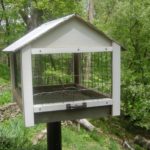
-
Adaptation to feeder
-
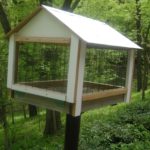
-
Back View of feeder
by Winding Pathways | Mar 17, 2018 | Garden/Yard, Geology/Weather, Mammals, Nature, Wonderment
Don’t Miss March’s Launch of Spring
“If we do not permit the earth to produce beauty and joy
it will in the end not produce food either,” Joseph Wood Krutch.
Too many people miss March’s majesty by staying indoors. After all it’s usually too warm to enjoy cross country skiing or ice fishing and it’s too early to plant the garden, go fishing, or play golf. March is the month of mud, fog, slowly melting grit-encrusted snowbanks, and clammy cold.
At Winding Pathways, we defy normal behavior and spend March days outdoors. It’s the month of great change and nature’s cavalcade is there for any observant person to enjoy.
Just consider the earth and how it’s turning toward our sun. Days lengthen the most around the March 21st Vernal Equinox. This means there is more sunlight each day allowing our yard to soak up more solar energy and spark spring’s revival of life.
March is the month to pull on mud boots and venture outdoors with eyes and ears attuned to the great seasonal change upon us. Here are some things to absorb with great joy:
-
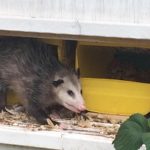
-
“Possum come aknockin’ at the door.”
-

-
Look Up and see skeins of geese winging across the sky
-
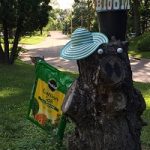
-
Gardening
Birds.
Migration has started. Look up! Way up. Skeins of geese wing high overhead, perhaps so high they are mere specs. Binoculars bring them closer. And their distant and distinct song is music to winter weary ears. Salute their northward journey with a hearty, “Welcome Back!” Many smaller birds are on the prowl, but it may take a close look to notice them. Within a month juncos disappear shortly after red winged blackbirds make their annual debut. Sparrows begin crafting messy nests as goldfinches swap their drab winter outfits for glorious yellow garb. Barred owls fill the night air with haunting cries of WHO COOKS FOR YOU FOR YOU. Sometimes they are in a black oak almost over our roof and startle us awake with their lusty calls.
Mammals.
Even as winter’s song hangs on, baby squirrels are nestling in tree cavities and rapidly growing on a diet of mom’s rich milk. Squirrels are among nature’s most attentive mothers. In another month or two they encourage their babies to venture outdoors. Cottontails begin mating, buck deer begin growing new antlers, chipmunks are increasingly active, and raccoons and opossums prowl the nocturnal yard seeking dinner. On warm misty nights they gorge on nightcrawlers that have emerged on the lawn’s surface to mate.
Plants.
We’re always delighted to find stinging nettles springing out of the still cold earth toward the end of March. There’s no better tasting or nutritious cooked green than a short pile of steaming bright green nettles on the dinner plate. It’s the best time of the year to enjoy tender dandelions leaves in salad. We like the non-bitter blanched leaves discovered under a carpet of oaks. By summer, these leaves are too tough and bitter to enjoy. But, now, they are delicious and nutritious. We can pluck them because we have a spray-free yard.
Spring’s miracle sound.
Sometimes this miraculous sound happens in March but always by early April. Nature’s most promising song comes at vespers each spring, usually in the calendar interval where Easter can fall – March into April. Spring peepers and chorus frogs herald the season each evening. As Christians worldwide celebrate Easter by saying HE IS RISEN, Chorus frogs and peepers enthusiastically seem to announce SPRING IS COMING!
Go Outside! Don’t miss the great vernal seasonal turn. March isn’t a month to huddle by the television. It’s a month to be outside.
-
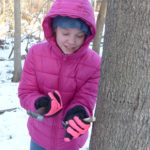
-
Girls taps a Maple Tree
-
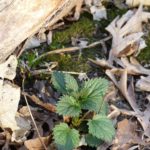
-
Nettles are one of the first greens to poke up through the ground.
-
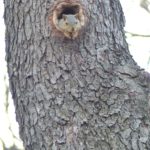
-
Young Squirrel in tree.
-
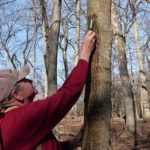
-
Sapsucker holes in tree.
-
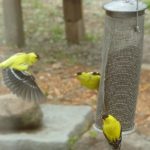
-
Male Goldfinches begin to color up.
-
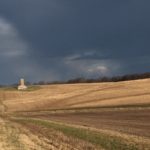
-
Dark clouds over farmland.
by Winding Pathways | Feb 22, 2018 | (Sub)Urban Homesteading, Garden/Yard, Mammals
Moles in winter? You bet! We were amused and amazed to look out our den window and see a heaped-up line of topsoil on top of several stepping stones. Even in Winter, our moles are active!
Many people hate moles because their tunneling raises mini ridges in the lawn and their hills smother a patch of grass and get
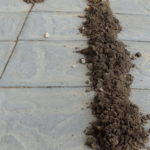
Moles bring rich dirt from below to the surface as they tunnel along hunting for earthworms and grubs.
caught in a lawnmower’s blades. Some go to great lengths to poison or kill moles.
How Moles Are Helpful
We don’t. They’re amazing animals that provide us with a wonderful service. Their endless digging in search of earthworm and insect meals softens the soil, enabling water to easily percolate in and helping plants grow. The greenest grass of the lawn always seems to be where moles tunneled last year.
Instead of persecuting our moles we simply stomp down the raised tunnels and rake out the mole hill before mowing, and then we quietly thank our subterranean helpers before starting up the lawnmower.
Moles are active all year but the frozen ground is daunting for them. Our January moles were tunneling in the soft unfrozen soil on the south side of the house and under dark stones that catch the sun’s heat and keep the ground underneath them unfrozen. We hope they found some grubs and worms for dinner.
We’re happy to share our yard with moles and appreciate the positive impact they have on the soil. Watch this YouTube Video about moles.
by Winding Pathways | Jan 25, 2018 | Mammals, Trees/Shrubs
Winter is the best time to spot dens and nests. Usually, we think of bird nests, and we see abandoned ones topped with mounds of snow along roadsides and in shrubs. When we look up, we also spot large clusters of leaves and sticks – squirrel nests.
Squirrels make two types of nests: dens and dreys. Dens are cavities in trees and dreys are the large balls of leaves and sticks that squirrels fashion. From the ground, these dreys look small, but they are really good sized.
Dens

Taking in the view from the safety of a tree den.
When squirrel families mature in late summer, the young venture forth to find new lodgings. If the population of squirrels is low and the availability of hollows in trees is high, then squirrels take the dens. These are hollow spaces inside the trunk that squirrels line with leaves and bits of fur and bark. Squirrels do not create these hollows but use them. Wood rot and woodpeckers create the spaces and squirrels make the most of them. Dens offer great protection from the elements and predators and they are warmer. So, squirrels conserve their energy when they must “hole up” during winter storms. When the worst of the harsh weather passes, squirrels begin to stir, digging for nuts and raiding bird feeders.
Dreys
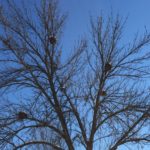
Squirrel Condominium
Squirrels make their dreys near sturdy forks in branches or close to the tree trunk. They will be high up for protection from predators. Usually, a tree might support one or two squirrel nests, but occasionally, we see half a dozen scattered throughout a wide-branching deciduous tree. Squirrel condominiums. These might be secondary homes or extensions of families. Secondary homes tend to be more loosely constructed and are scattered near the main home tree and serve as shelter in case a squirrel gets caught out in the elements or is being chased by a predator.
Each nest begins with a study base of twigs. Scientists have discovered that sometimes squirrels weave grapevines into the structure along with leaves, bark, moss, and twigs for added support. After all, the nest sways in the branches and get buffeted by winds, rain, and snow, so it needs to be strong. Inside, the nest is dry and warm.
When you are driving or walking look up and spot the nests of one of our most industrious small mammals. Squirrels mate in January and soon the young will be born – in the bleak mid-winter maybe in a squirrel condominium near you!
by Winding Pathways | Nov 2, 2017 | Chickens, Mammals, Nature
Below is a guest blog by Arianne Waseen about a visit by an opossum. Thanks, Arianne!

“Possum come aknockin’ at the door.”
“I went out in the afternoon a few weeks ago to look for eggs. I opened up the large door on the front of our coop, and in the nest box was something grey and furry and curled up in a little ball. My first thought was that it was a cat, but looking more closely it was definitely possum fur. I yelled and jumped a bit, and ran in to tell my husband and mother-in-law to come take a look. By the time we got back the possum had woken up. We opened up a little door we have at the back of the nest box and my mother in law encouraged the possum to jump down by prodding it with a broom from the front of the nest box. It jumped down and ran off. The opossum has come back a few times, and while it has not harmed our chickens, we are getting fewer eggs than we should be, and the possum has suspiciously glossy fur.”
























